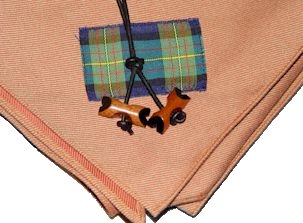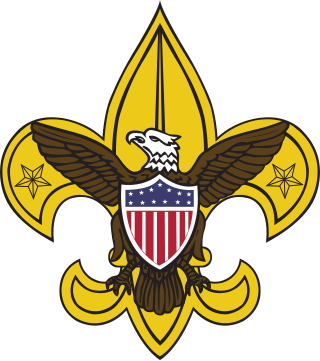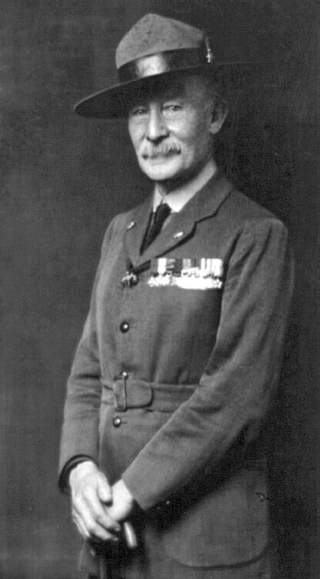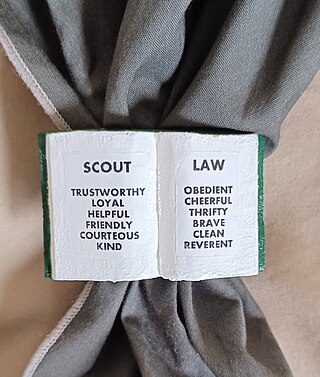
A woggle (or neckerchief slide) is a device to fasten the neckerchief, or scarf, worn as part of the Scout or Girl Guides uniform, originated by a Scout in the 1920s.

A woggle (or neckerchief slide) is a device to fasten the neckerchief, or scarf, worn as part of the Scout or Girl Guides uniform, originated by a Scout in the 1920s.

One story relating to the origin of the word 'woggle' is that it was named to rhyme with the word boon doggle used in America. However the term woggle pre-dates the first known reference to this in 1925. [1] There are a few other references to the word woggle before its adoption by the Scout movement. It is thought that woggle was a verb, with similar meanings to waggle and wobble, in the 16th century. It was in limited use as a noun around 1900. [1]
Another report is that William 'Bill' Shankley, while working at Gilwell Park with Scouting's founder, prior to 1922, called it a woggle, 'a name given to something without a name'. [2]
The earliest known reference to a woggle is the June 1923 edition of British The Scout . The term was quickly applied to other designs of fastener, of many shapes and sizes, and is today used around the world.
The word ring was used in editions of the Scouting handbook Scouting for Boys until 1929 when Baden-Powell changed it in the 14th edition:
It [the scarf] may be fastened at the throat by a knot or woggle, which is some form of ring made of cord, metal or bone, or anything you like. [3]
Early Scouts tied a knot in their neckerchief (scarf) to fasten it around the neck. In the United States, experiments were made with rings made from bone, rope or wood. [3]
A young British Scouter, Bill Shankley, who was responsible for running a workshop and developing ideas for camping equipment at Gilwell Park, became aware of the American rings, and set out to create something similar. The result was the Gilwell Woggle. [4] [5]
On the origin of the woggle, Shankley said:
They used to knot their scarves, which used to get creased and stick out at the ends. But in America the early Scouts used to plait up various stuffs to make a ring for theirs — they called it a boon-doggle. I got some thin sewing machine leather belting, plaited it into a neat ring, submitted it, and had it accepted. I called it a Woggle and that's the name it's known by throughout the world. [4]

The Turk's head knot woggle designed by Bill Shankley became known as the Gilwell Woggle, as it has been traditionally presented to leaders who have completed their Wood Badge training. Trained leaders are admitted into 1st Gilwell Park Scout Troop, with the Gilwell Woggle as one of its symbols (since at least 1926). [6] [7] Because of its association with leader training, it is not worn by other Scouts.
Shankley's original Gilwell woggle is at the Scout Heritage Museum in Tasmania. [2]

The New Zealand Scouts sometimes use a plastic woggle in the shape of a traditional Maori carved head. More commonly though warranted leaders trained to Gilwell Woggle standard are allowed to wear the "traditional" leather Turk's head woggle. Keas, Cubs, Scouts, Venturers and Rovers all wear either a "standard" woggle for their section, or home-made "special occasion" woggles such as the tiki mentioned above. Until trained to the Gilwell woggle level, leaders wear a plaited leather woggle with a dome fastening. [3]
Although the name woggle is used in many English-speaking countries, in the United States, the term woggle is reserved for the turk's head knot used to secure the neckerchief of Wood Badge participants. In the US, the object used to secure the neckerchief is called a neckerchief slide .

An early photographic reference to a slide is in the Boy Scouts of America (BSA) magazine Scouting of 1 April 1917. The cover for November 1917 issue prominently shows a Scout wearing a slide to hold the neckerchief in place. [8]
In the BSA magazine Scouting from August 1923, the term "slip-on" and "slide" are both referenced. There is an example of a rams head made of bone and an illustration on how to make your own Turk's head slip-on. The article also comments that the neckerchief should be tied using the four-in-hand knot (often used to tie a necktie) when not using a slide. [9]
Two months later, Boys' Life magazine repeated many of the article key points. The name slide or neckerchief slide appears as early as October 1923 with a discussion of the slide being a smart addition to the neckerchief and having some benefits over a knot to tie the neckerchief on. The article makes reference to making a troop's or patrol's own slide. In the same article, on page 63, the slide is referred to as a "Slip-On". [10]
In the 1930s through the 2000s, Boys' Life magazine (the Boy Scouts of America youth magazine) promoted the use and making of slides through articles and Slide Contests.
In the 1920s and 1930s, Boys' Life sponsored contests for unique slides, and winning designs were featured in the magazine. In the late 1940s, a feature article called Slide of the Month began to grace the pages. Most of the articles were written by W. Ben Hunt from Hales Corners, Wisconsin under the pen name "Whittlin' Jim". [11] Many of the slide ideas were sent into the magazine by Scouts and Scouters as evidenced by the notes Jim included in the article thanking individuals for the slide ideas. After Mr. Hunt's death in the early 1970s, several authors took on the "Slide of the Month" responsibility. The last article was printed in March 2001, the "Rattlesnake" made from wire, tube, colored tape, beads, and googly eyes. [12] Over 300 Slide of the Month articles appeared in Boys' Life magazine.
The first appearance of the term "woggle" in Boys' Life was in February 1966 with reference to a question in a quiz, asking what woggle is to a British Scout. [13]

A knout is a Russian whip, that consists of rawhide thong or a rope attached to a long wooden handle; construction varies. Commonly used for prodding horses or cattle, flagellation by a knout has become notorious as a means of corporal punishment in Russian history. The English word stems from a spelling-pronunciation of a French transliteration of the Russian word кнут (knut), which simply means "whip".

A neckerchief, sometimes called a necker, kerchief or scarf, is a type of neckwear associated with those working or living outdoors, including farm labourers, cowboys and sailors. It is most commonly still seen today in the Scouts, Girl Guides and other similar youth movements. A neckerchief consists of a triangular piece of cloth or a rectangular piece folded into a triangle. The long edge is rolled towards the point, leaving a portion unrolled. The neckerchief is then fastened around the neck with the ends either tied or clasped with a slide or woggle.

Wood Badge is a Scouting leadership programme and the related award for adult leaders in the programmes of Scout associations throughout the world. Wood Badge courses aim to make Scouters better leaders by teaching advanced leadership skills, and by creating a bond and commitment to the Scout movement. Courses generally have a combined classroom and practical outdoors-based phase followed by a Wood Badge ticket, also known as the project phase. By "working the ticket", participants put their newly gained experience into practice to attain ticket goals aiding the Scouting movement. The first Wood Badge training was organized by Francis "Skipper" Gidney and lectured at by Robert Baden-Powell and others at Gilwell Park in September 1919. Wood Badge training has since spread across the world with international variations.
Slide or Slides may refer to:

Cub Scouts, Cubs or Wolf Cubs are programmes associated with Scouting for young children usually between 7 and 12, depending on the organisation to which they belong. A participant in the programme is called a Cub. A group of Cubs is called a "Pack".

A scarf is a long piece of fabric that is worn on or around the neck, shoulders, or head. A scarf is used for warmth, sun protection, cleanliness, fashion, religious reasons, or to show support for a sports club or team. Scarves can be made from materials including wool, linen, silk, and cotton. It is a common type of neckwear and a perennial accessory.

Malaysian Scouts Association, officially known as the Scouts Association of Malaysia, is the largest informal youth and educational organisation in Malaysia, and member of World Organization of the Scout Movement (WOSM).

Cub Scouting is part of the Scouting program of the Boy Scouts of America (BSA), available to boys and girls from kindergarten through fifth grade, or 5 to 10 years of age and their families. Its membership is the largest of the five main BSA divisions. Cub Scouting is part of the worldwide Scouting movement and aims to promote character development, citizenship training, personal fitness, and leadership.

A Turk's head knot, sometimes known as a sailor's knot, is a decorative knot with a variable number of interwoven strands forming a closed loop. The name refers to a general family of knots, not an individual knot. While this knot is typically made around a cylinder, it can also be formed into a flat, mat-like shape. Some variants can be arranged into a roughly spherical shape, akin to a monkey's fist knot.
A boondoggle is a scheme that wastes time and money.
L'Association des Scouts du Canada (ASC) is a Canadian Scouting organization. ASC is a World Organization of the Scout Movement "affiliated organization" through affiliation with Scouts Canada. Scouts du Canada primarily serves French speaking Scouting in Canada.

The Boy Scouts of America (BSA) use uniforms and insignia to give a Scout visibility and create a level of identity within both the unit and the community. The uniform is used to promote equality while showing individual achievement. While all uniforms are similar in basic design, they do vary in color and detail to identify the different membership divisions of Cub Scouting, Scouts BSA and Venturing. Many people collect BSA insignia such as camporee and jamboree emblems, council shoulder strips and historical badges.

A Scout leader or Scouter generally refers to the trained adult leader of a Scout unit. The terms used vary from country to country, over time, and with the type of unit.

Scouts BSA is the flagship program and membership level of the Boy Scouts of America (BSA) for boys and girls between the ages of typically 11 and 17. It provides youth training in character, citizenship, and mental and personal fitness. Scouts are expected to develop personal religious values, learn the principles of American heritage and government, and acquire skills to become successful adults.

Scouts' Day or Guides' Day is a generic term for special days observed by members of the Scouting movement throughout the year. Some of these days have religious significance, while others may be a simple celebration of Scouting. Typically, it is a day when all members of Scouting will re-affirm the Scout Promise.

The Pathfinder & Rover Explorer Scouts' Association (P-RESA) is an independent Traditional Scouting Association in the United Kingdom, with International branches. The Association's training programme runs along the lines of Baden-Powell's original Scouting for Boys, upholding the traditions and practices set out by B-P, using the 1938 Boy Scouts' Association Policy Organisation & Rules (POR) as its basis.

Richard Francis "John" Thurman OBE JP was a British Scouting notable and Camp Chief of Gilwell Park from 1943 to 1969 and scouting’s first International Director of Adult Leader Training

The Irish Girl Guides is a Girl Guides organisation in the Republic of Ireland. Together with the Catholic Guides of Ireland, it forms the Council of Irish Guiding Associations. Whereas the Catholic Guides are an all-Ireland body, the Irish Girl Guides are not organised in Northern Ireland, where Girlguiding Ulster, the branch of Girlguiding UK, operates instead.

William Frederick de Bois Maclaren was publisher, businessman and Scout Commissioner for Rosneath, Dunbartonshire, Scotland. He is most recognized as the first major benefactor of Scouting by donating Gilwell Park in 1919.

The Slide of the Month was a series of articles published in Boys’ Life running from February 1951 to March 2001. Boys’ Life was the predecessor to Scout Life, the current magazine published by Boy Scouts of America. Several authors contributed to the articles over the years. Most involved whittling wood. However, other crafts were used for specific projects including beadwork, horn carving, and some metalwork. Common materials such as wood, leather, beads, metal are usually used. However, some unusual materials can be found including animal bone, fungi or pieces of armadillo tail. The frequency varied from one period to another: sometimes monthly and other times only once a year.